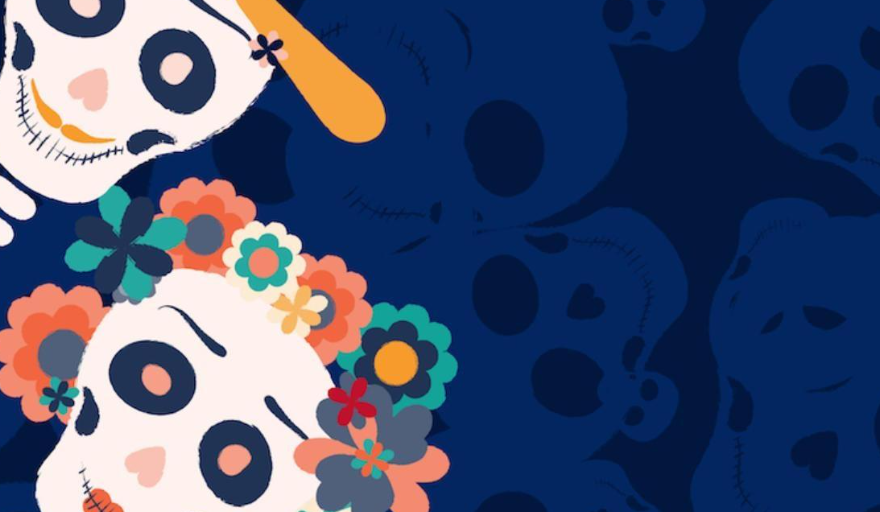Día de los Muertos, or the Day of the Dead, is unique in honoring dear departed souls. Many Spanish-speaking communities, particularly in Mexico, celebrate this holiday as a time to reflect and celebrate their deceased. Recently, a local community came together and celebrated this particular holiday with colorful festivities that united families and exposed their traditions to others.
The event took place in the community center, hosting the many traditional features of Día de los Muertos. A strong tradition is the making of ofrendas – altars built in memory of the dead. These altars were decorated with marigold flowers, candles, sugar skulls, and pictures of family members who have passed away. Families put favorite foods, beverages, and belongings of their lost loved ones into the altars because they believed that such offerings could help bring the spirits of their dearly departed back for a visit.
For many, making ofrendas was an intimate, personal experience. “It’s a way to remember them and celebrate their lives,” said Carmen Morales, a local resident.” We’re not just mourning, but honoring everything they gave us.”
The fiesta also included Mariachi bands and traditional folk dancing. Music and dancing are part of the event because they are supposed to help guide the spirits back to the families. Food vendors supplied all the delicious food, including tamales, pan de muerto, and atole. Such foods provided much enjoyment, both for the taste of tradition and for the company.
Children had a great time painting their faces; they were transformed into colorful sugar skulls during this time. It was a defining moment where children learned that this day is not tragic but one that remembers those who have passed away and one that can celebrate life in so many different ways.
Such moments included a storytelling session in which the older participants told stories of their ancestors and what Día de los Muertos means. This helped bridge the intergenerational gap and represented their connection with their heritage, helping the youth become aware that the past comes to them in memory. “This is how we keep our culture alive,” said José Pérez, one of the elder members of this community. “We share our stories so that our children will learn and take them on.”
Día de los Muertos, while of Mexican origin, gets celebrated worldwide in different ways among many Spanish-speaking communities. To people who had very little exposure to this holiday, the fest gave an ideal insight into the traditions of the event, allowing the audience an appreciation of their meanings. It was a beautiful display of culture and how traditions can merge together along cultural lines.
If a number of families celebrate Día de los Muertos, it is with the spirit of linking themselves with the past through the glorification of the lives of their ancestors. “We honor those who have passed,” said Ana López, another participant, “but we also teach our
children to keep their memories alive.”
For that reason, Día de los Muertos is a time to honor those who have shaped our lives, celebrate their lives, and preserve their memory through traditions to be passed down through families and communities.
Spanish Translation
El Día de los Muertos es un día especial para recordar y honrar a las personas que ya no están. Muchas comunidades, especialmente en México, celebran este día para celebrar la vida de los muertos. Recientemente, una comunidad local celebró esta fiesta con muchas tradiciones que unieron a las familias y compartieron sus costumbres con otras personas.
El evento se realizó en el centro comunitario, donde se celebraron muchas tradiciones del Día de los Muertos. Una de las más importantes es la creación de las ofrendas, que son altares para recordar a los muertos. Estos altares tenían flores de cempasúchil, velas, calaveras de azúcar y fotos de los familiares que han partido. Las familias ponían en los altares comida, bebida y objetos favoritos de las personas que ya no están. Creen que esto ayuda a que los espíritus regresen a visitarlos.
Para muchas personas, hacer las ofrendas es algo muy personal. “Es una forma de recordar y celebrar sus vidas”, dijo Carmen Morales, una residente local. “No solo estamos tristes, también honramos lo que nos dieron.”
La fiesta también tuvo música de Mariachi y bailes tradicionales. La música y el baile son importantes porque se cree que ayudan a que los espíritus regresen con las familias. También había puestos de comida con tamales, pan de muerto y atole, que todos
disfrutaron mucho.
Los niños también se divirtieron mucho al ponerse cara de calavera de azúcar. Fue un momento importante para que los niños aprendieran que este día no es triste, se celebra la vida y a quienes ya no están.
También se realizó una sesión de cuentos, en la que las personas mayores contaron historias sobre sus ancestros y lo que significa el Día de los Muertos. Esto ayudó a los jóvenes a aprender sobre las tradiciones y a entender cómo el pasado sigue vivo en las historias. “Así mantenemos nuestra cultura viva”, dijo José Pérez, un miembro mayor de la comunidad. “Compartimos nuestras historias para que los niños las aprendan.”
Aunque el Día de los Muertos es una tradición mexicana, se celebra en muchas comunidades de habla hispana en todo el mundo. Para las personas que no conocían mucho sobre esta fiesta, el evento les dio una idea de lo que significa y les ayudó a apreciar la cultura.
El Día de los Muertos es un momento para honrar a las personas que han partido, celebrar sus vidas y mantener su recuerdo vivo a través de las tradiciones que se pasan de generación en generación. “Honramos a los que se han ido”, dijo Ana López, otra participante, “pero también enseñamos a nuestros hijos a recordarles.”
